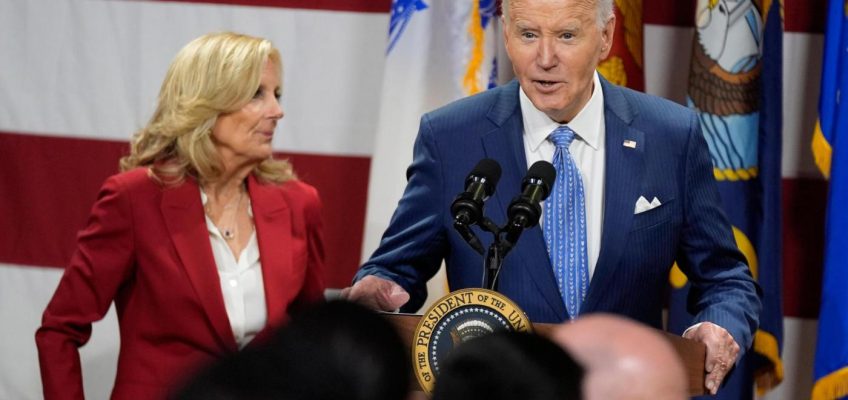By KIMBERLEE KRUESI, Associated Press
NASHVILLE, Tenn. (AP) — Married couples across the U.S. have had access to no-fault divorce for more than 50 years, an option many call crucial to supporting domestic abuse victims and key to preventing already crowded family courts from drowning in complicated divorce proceedings.
But some advocates for women worried as old comments from now Vice President-elect JD Vance circulated during the presidential campaign opposing no-fault divorce. And after President-elect Donald Trump and Vance won the election, warnings began popping up on social media urging women who might be considering divorce to “pull the trigger” while they still could. Some attorneys posted saying they were seeing a spike in calls from women seeking divorce consultations.
Trump — who is twice-divorced — hasn’t championed overhauling the country’s divorce laws, but in 2021 Vance lamented that divorce is too easily accessible, as have conservative podcasters and others.
“We’ve run this experiment in real time and what we have is a lot of very, very real family dysfunction that’s making our kids unhappy,” Vance said during a speech at a Christian high school in California, where he criticized people being able to “shift spouses like they change their underwear.”
Despite concerns, even those who want to make divorces harder to get say they don’t expect big, swift changes. There is not a national coordinated effort underway. And states determine their own divorce laws, so national leaders can’t change policy.
“Even in some of the so-called red states, it hasn’t gotten anywhere,” said Beverly Willett, co-chair of the Coalition for Divorce Reform, whose group has unsuccessfully attempted to convince states to repeal their no-fault divorce laws.
Mark A. Smith, a political science professor at the University of Washington, said that while many Americans have become accustomed to no-fault divorce being an option, Vance’s previous comments on making it more difficult to separate from a spouse could help jumpstart that effort.
“Even though he’s not directly proposing a policy, it’s a topic that hasn’t gotten a ton of discussion in the last 15 years,” Smith said. “And so to have a national profile politician talk that way is noteworthy.”
Meanwhile, Republican Party platforms in Texas and Nebraska were amended in 2022 to call for the removal of no-fault divorce. Louisiana’s Republican Party considered something similar earlier this year but ultimately declined to do so.
A handful of proposals have been introduced in conservative-led statehouses over the years, but all immediately stalled after they were filed.
In January, Oklahoma Republican Sen. Dusty Deevers introduced legislation that would have removed married couples from filing for divorce on the grounds of incompatibility. Deevers backed the bill after writing a piece declaring no-fault divorce was an “abolition of marital obligation.”
Similarly, in South Carolina, two Republican lawmakers in 2023 filed a bill that would have required both spouses to file for a no-fault divorce application rather than just one. And in South Dakota, a Republican lawmaker has attempted to remove irreconcilable difference as grounds for divorce since 2020.
None of the sponsors of these bills responded to interview requests from The Associated Press. All are members of their state’s conservative Freedom Caucus.
Nevertheless, some Democratic lawmakers say they remain worried about the future of no-fault divorce. They point to the U.S. Supreme Court overturning the constitutional right to abortion in 2022 as an example of a long-accepted option that was revoked through a decades-long effort.
“When you choose to be silent, you allow for this to creep in,” said Democratic South Dakota Rep. Linda Duba. “These are the bills that gain a foothold because you choose to be silent.”
Before California became the first state to adopt a no-fault divorce option in 1969, married couples had to prove their spouse had violated one of the approved “faults” outlined in their state’s divorce law or risk a judge denying their divorce, said Joanna Grossman, a law professor at Southern Methodist University in Dallas. Qualified reasons varied from state to state, but largely included infidelity, incarceration or abandonment.
The system was a particular burden on domestic violence victims, often times women, who could be stuck in dangerous marriages while they try to prove their partner’s abuse in court through expensive and lengthy legal proceedings.
“If there was any evidence that the couple both wanted to get divorced that was supposed to be denied because divorce was not something you got because you wanted it, it was something you got because you’ve been wronged in a way that the state thought was significant,” Grossman said.
To date, every state in the U.S. has adopted a no-fault divorce option. However, 33 states still have a list of approved “faults” to file as grounds for divorce — ranging from adultery to felony conviction. In 17 states, married people only have the option of choosing no-fault divorce to end their marriages.
Biden proposes Medicare and Medicaid cover costly weight-loss drugs for millions of obese Americans
David French: Donald Trump thinks he won’t have enough power?
Trump threatens to impose sweeping new tariffs on Mexico, Canada and China on first day in office
After Trump’s win, Black women are rethinking their role as America’s reliable political organizers
Special counsel moves to abandon election interference, classified documents cases against Trump
Calls to reform no-fault divorce have remained fairly silent until the late 1990s, when concern pushed by former President George Bush’s administration over the country’s divorce rate sparked a brief movement for states to adopt “covenant marriages.” The option didn’t replace a state’s no-fault divorce law, but provided an option for couples that carried counseling requirements and strict exceptions for divorce.
Louisiana was the first state to embrace covenant marriage options, but the effort largely stopped after Arizona and Arkansas followed suit.
Christian F. Nunes, president of the National Organization for Women, said she is “extremely worried” about the possibility of no-fault divorce being removed with the incoming Trump administration, Republican-controlled Congress and wide range of conservative state leaders.
“With so many states focusing on a misogynistic legislative agenda, this will turn back the clocks on women’s rights even more,” Nunes said in a statement. “This is why removing ‘no fault’ divorce is another way for the government to control women, their bodies, and their lives. Eliminating no-fault divorce is also a backdoor way of eliminating gay marriage, since this implies that a marriage is only between a man and a woman.”
With Trump’s reelection, Willett, whose group opposes no-fault divorce, said she’s cautiously optimistic that the political tide could change.
“Was what he said an indication of things to come? I don’t know,” Willett said. “It’s a good thing but it’s certainly not anything that has been really discussed other than a few high profile conservatives who talk about it.”




